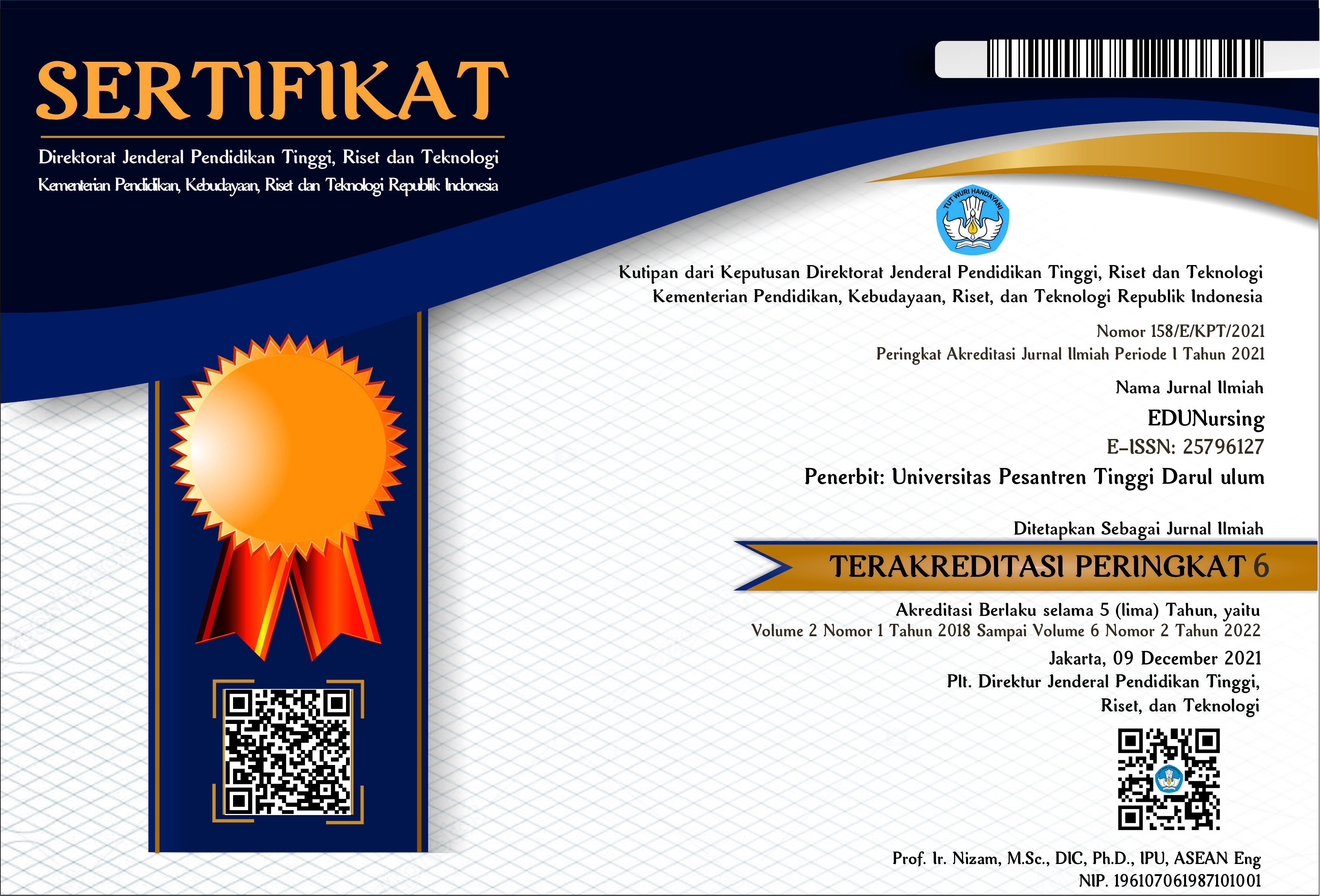PENGETAHUAN PERAWAT TENTANG KETEPATAN IDENTIFIKASI PASIEN DI RS. PMC JOMBANG
https://doi.org/10.26594/edunursing.v2i2.1839
Abstract
ABSTRACT
Knowledge is the result of "know" and this happens after the person inserts the sensing. Knowledge or cognitive is a very important domain for the formation of one's actions (behavior Ovent) (Wawan & Dewi, 2011). The purpose of this study was to determine the level of nurse knowledge about accuracy with the right patient, at Rs. Complementary Medikal Center. This research uses Descriptive research design with population of 60 respondents and sample size. 52 respondents who have filled sample and sample technique which is Simple Random Sampling. Then enter the data using a questionnaire filled by the nurse. Then to find out information about how to measure the accuracy between patients. The results show that the research is mostly knowledge of the patient, the current patient, the time before giving the drug and the product, the time before taking the sample and the time before doing the action or good. Therefore, it can be clearly known about the patient appropriately, at Rs. Complementary Medikal Center Jombang.
Keywords: Nurse knowledge, patient identification, accuracy.
References
DAFTAR PUSTAKA
Arikunto.(2013). Prosedur Penelitian Suatu Pendekatan Praktis. Jakarta: Rineka Cipta.
Bakhtiar, A., (2012). Filsafat Ilmu.Rajawali Pers. Jakarta.
Departemen Kesehatan (Depkes) RI, (2008).Panduan Nasional Keselamatan Pasien Rumah Sakit Utamakan Keselamatan Pasien Edisi 2. Jakarta: Depkes.
Dirjen Bina Upaya Kesehatan., (2012). Kebijakan Pelayanan Instalasi Gawat Darurat di Rumah Sakit, Bulletin BUK Edisi I Tahun 2012, Jakarta.
Hamdani, Siva. (2007). Analisis Budaya Keselamatan Pasien (Patient safety Culture) Di Rumah Sakit Islam Jakarta Tahun 2007.
Kemenkes RI. (2011). Standar Akreditas Rumah Sakit, Kerjasama Direktorat Jenderal Bina Upaya Kesehatan Kementerian Kesehatan Republik Indonesia dengan Komisi Akreditasi Rumah Sakit. KARS: Jakarta.
Kementerian Kesehatan. (2011). Permenkes RI Nomor 1691/Menkes.Per/Viii/2011 Tentang Keselamatan Pasien Rumah Sakit.
Komisi Akreditasi Rumah Sakit. Panduan Penyusunan Dokumen Akreditasi. (2012). KARS: Jakarta.
Komite Keselamatan Rumah Sakit (KKP- RS) PERSI.,(2012). Pedoman Pelaporan Insiden Keselamatan Pasien. Jakarta.
Mubarak, W, I. (2012). Ilmu kesehatan masyarakat konsep dan aplikasi dalam kebidanan, Jakarta; Salemba Mendika.
Notoatmodjo, S. (2012).Metodologi penelitian Kesehatan.Rineka cipta. Jakarta.
Nursalam. (2016). Manajemen Keperawatan Aplikasi dalam Praktik Keperawatan. EGC: Jakarta.
Nursalam.(2016). Metodologi penelitian Ilmu Keperawatan: Pendekatan Praktis Edisi 3. Jakarta : Salemba Medika.
Notoatmodjo,S. (2012).Promosi KesehatanDanIlmu Perilaku. Jakarta:RinekaCipta.
PMK No.1691/MENKES/PER/VIII/2011 Tentang keselamatan pasien rumahsakit.
Sastroasmoro, S. (2014). dasar-dasar metodelogi penelitian klinis. edisi ke-5: sagung seto.
Sugiono.(2014). Metode Penelitian Kuantitatif, Kualitatif dan R& D. Bandung: Alfabeta.
Swasky, S. (2007). Could employment based targeting approach save Egypt in moving toward a social health insurance models. EMHJ (East Mediteranian Health Journal) , 2.
Verdiansyah, D. (2013). Filsafat ilmu komunikasi suatu pengantar.PT Indeks Kelompok Gramedia; Jakarta.
Wawan, A & Dewi, M. (2011).Teori Dan Pengukuran Pengetahuan Sikap dan Perilaku Manusia.Yogyakarta : Nuha Medika.
Widyana, Ayu Niluh. Dkk. 2014.Gambaran Pengetahuan Pasien TentangPemasanganGelang Identifikasi Pasien Di Instalasi Rawat Inap, Program Studi Ilmu Keperawatan Fakultas Kedokteran Universitas Sam Ratulangi.
Downloads
Published
How to Cite
Issue
Section
License









